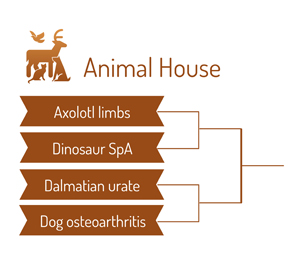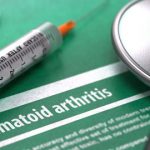 Editor’s note: RheumMadness is the place for everyone crazy about rheumatology to connect, collaborate, compete and learn together. During RheumMadness, rheumatology concepts represent teams that compete against each other in a tournament, much like basketball teams do in the NCAA’s March Madness tournament. In a series for The Rheumatologist, readers will get a chance to read the scouting reports for each concept team. These reports are written by rheumatology fellows from 13 programs throughout the U.S.
Editor’s note: RheumMadness is the place for everyone crazy about rheumatology to connect, collaborate, compete and learn together. During RheumMadness, rheumatology concepts represent teams that compete against each other in a tournament, much like basketball teams do in the NCAA’s March Madness tournament. In a series for The Rheumatologist, readers will get a chance to read the scouting reports for each concept team. These reports are written by rheumatology fellows from 13 programs throughout the U.S.
Don’t forget to submit your RheumMadness 2022 bracket by March 25. The more your picks match those of our Blue Ribbon Panel of rheumatologists, the more points you get. Learn more about the panel and how the brackets work online.
Connect with RheumMadness by subscribing to the podcast and joining the conversation on Twitter, #RheumMadness. Learn more on the RheumMadness website.
Region: Animal House Team: Dalmatian Urate
Humans and great apes are the only mammals that lack uricase, an enzyme that metabolizes purines into allantoin, which is easily excreted in urine. Instead, in hominidae, purines are broken down into uric acid, which in elevated levels can lead to gout.
Dalmatians, like most mammals, possess uricase. Unlike other dog breeds, they have defects in both renal tubular reabsorption of filtered urate and the hepatic conversion of uric acid to allantoin. Thus, Dalmatians can provide unique insight into uric acid homeostasis. Although these defects roughly offset one another, they still lead to elevated urinary uric acid levels that increase the risk of uric acid nephrolithiasis in Dalmatians.1
 Organ transplant studies have helped elucidate the specific driver of elevated uric acid in the Dalmatian breed. Reciprocal renal transplants between Dalmatians and mutts (i.e., non-breed dogs) demonstrated that transplanted donor kidneys assumed the urinary excretion pattern of the recipient.1 In contrast, a study of reciprocal hepatic transplants showed that the urinary excretion and serum urate of the recipient followed that of the donor liver. These findings suggest the liver is the main driver of uric acid metabolism in Dalmatians.
Organ transplant studies have helped elucidate the specific driver of elevated uric acid in the Dalmatian breed. Reciprocal renal transplants between Dalmatians and mutts (i.e., non-breed dogs) demonstrated that transplanted donor kidneys assumed the urinary excretion pattern of the recipient.1 In contrast, a study of reciprocal hepatic transplants showed that the urinary excretion and serum urate of the recipient followed that of the donor liver. These findings suggest the liver is the main driver of uric acid metabolism in Dalmatians.
Initially, this phenomenon was hypothesized to be due to the presence of a promoter of urate uptake in the mutt liver or an inhibitor of urate uptake in the Dalmatian liver.
Further studies showed that with successful engraftment of mutt hepatocytes into Dalmatian livers, the Dalmatians experienced a decrease in serum urate levels and a decrease in urinary uric acid secretion. This finding suggests livers of mutts promote transport across hepatic membranes, as well as across renal cell membranes. The authors suggest this driver, evidently missing in Dalmatians, may be a circulating hormone—similar to insulin—that regulates the mobilization of the URAT1 transporter.1
The hunt is on to isolate this hormone for further studies, although such a chemical has not yet been isolated in humans or dalmatians to date.
Implications
Current implications: One candidate for uric acid transport is GLUT9. GLUT9 is a known glucose transporter encoded by the SLC2A9 (solute carrier family 2 member 9) gene and is found in kidneys, the liver and the intestine.2 This protein has been shown to function as a high-capacity, low-affinity urate transporter in humans and, likely, in dogs. Genetic variants in the SLC2A9 gene are associated with variations in serum uric acid level, fractional excretion of uric acid and even differential risk for gout.3,4 Causative mutations have not been determined. However, a missense mutation of this gene in dalmatians results in hyperuricemia and hyperuricosuria. Humans who have loss-of-function mutations in the SLC2A9 gene have been described in familial renal hypouricemia.5
Future implications: The inhibition of SLC2A9 may result in drastic reduction in serum uric acid levels. Would this medication increase the risk of uric acid stones as seen in dalmatians? Could we selectively modulate this transporter to have a strong enough uricosuric effect to prevent hyperuricemia while concurrently avoiding increased risk of urinary stone formation?
Chances in the Tournament
We are drooling to watch Dalmatian Urate’s first-round matchup against Dog OA, and we expect them to fetch a win over their ailing archrivals. Afterward, expect Dalmatian Urate to be an underdog against the rejuvenated Axolotl Limbs or the historically dominant Dinosaur SpA.
If they do make it out of the tournament’s first round, Dalmatian Urate will have trouble chasing down any of the teams from the Cells Region, especially CAR-T cells. Everyone hopes for a matchup with Dual Energy CT in Gout, which would lend flare for a dramatic final.
Kubra Bugdayli, MD, is a first-year fellow in the University of Texas Southwestern Rheumatology Fellowship Program, Dallas.
Brett Capel, MD, is a second-year fellow in the University of Texas Southwestern Rheumatology Fellowship Program, Dallas.
Yusuf Chao, MD, is a first-year fellow in the University of Texas Southwestern Rheumatology Fellowship Program, Dallas.
Melissa DeFoe, MD, is a second-year fellow in the University of Texas Southwestern Rheumatology Fellowship Program, Dallas.
Daniel Emesiani, MD, is a second-year fellow in the University of Texas Southwestern Rheumatology Fellowship Program, Dallas.
Joad Eseddi, MD, is a first-year fellow in the University of Texas Southwestern Rheumatology Fellowship Program, Dallas.
Nagendra Pokala, MD, is a first-year fellow in the University of Texas Southwestern Rheumatology Fellowship Program, Dallas.
Komal Patel, MD, is a second-year fellow in the University of Texas Southwestern Rheumatology Fellowship Program, Dallas.
Bonnie Bermas, MD, is a professor in the Department of Internal Medicine at University of Texas Southwestern Medical Center, Dallas.
Haidy Galous, MD, is an assistant professor in the Department of Internal Medicine at University of Texas Southwestern Medical Center, Dallas.
Andreas Reimold, MD, is a professor in the Department of Internal Medicine at the University of Texas Southwestern Medical Center, Dallas.
Guillermo Andres Quiceno, MD, is an associate professor in the Department of Internal Medicine and the director of the Rheumatology Fellowship Program at University of Texas Southwestern Medical Center, Dallas.
References
- Simkin PA. The dalmatian defect: A hepatic endocrinopathy of urate transport. Arthritis Rheum. 2005 Aug;52(8):2257–2262.
- Voruganti VS, Kent JW Jr, Debnath S, et al. Genome-wide association analysis confirms and extends the association of SLC2A9 with serum uric acid levels to Mexican Americans. Front Genet. 2013 Dec 16;4:279.
- Ebert K, Ludwig M, Geillinger KE, et al. Reassessment of GLUT7 and GLUT9 as putative fructose and glucose transporters. J Membr Biol. 2017 Apr;250(2):171–182.
- Vitart V, Rudan I, Hayward C, et al. SLC2A9 is a newly identified urate transporter influencing serum urate concentration, urate excretion and gout. Nat Genet. 2008 Apr;40(4):437–442.
- Ruiz A, Gautschi I, Schild L, et al. Human mutations in SLC2A9 (Glut9) affect transport capacity for urate. Front Physiol. 2018 Jun 18;9:476.
 Experience All of RheumMadness
Experience All of RheumMadness
During RheumMadness, rheumatology concepts represent teams that compete against each other in a tournament, much like basketball teams do in the NCAA’s March Madness tournament. In a series for The Rheumatologist, readers will get a chance to read the scouting reports. Check out the reports from each region:
Region: Cells
Region: Animal House
Region: Machines
Region: People
• False Positive MRI in Axial SpA
Don’t forget to submit your RheumMadness 2022 bracket by March 25. The winner of each match-up is decided by a seven-member Blue Ribbon Panel of rheumatologists. The panel will vote based on which topic they think is most important to patients, providers and researchers—both now and in the future. The more your picks match those of the panel, the more points you get. The tournament results will be released in four rounds from March 26–April 4. Prizes will be given to participants with the top scores in the following categories: 1) attending/APP, 2) fellow and 3) resident/medical student. The prize is a custom RheumMadness coffee mug and a lifetime of bragging rights.
Connect with RheumMadness by subscribing to the podcast and joining the conversation on Twitter, #RheumMadness. Learn on the RheumMadness website.



